Configurazione delle interfacce FTD in modalità Inline-Pair
Opzioni per il download
Linguaggio senza pregiudizi
La documentazione per questo prodotto è stata redatta cercando di utilizzare un linguaggio senza pregiudizi. Ai fini di questa documentazione, per linguaggio senza di pregiudizi si intende un linguaggio che non implica discriminazioni basate su età, disabilità, genere, identità razziale, identità etnica, orientamento sessuale, status socioeconomico e intersezionalità. Le eventuali eccezioni possono dipendere dal linguaggio codificato nelle interfacce utente del software del prodotto, dal linguaggio utilizzato nella documentazione RFP o dal linguaggio utilizzato in prodotti di terze parti a cui si fa riferimento. Scopri di più sul modo in cui Cisco utilizza il linguaggio inclusivo.
Informazioni su questa traduzione
Cisco ha tradotto questo documento utilizzando una combinazione di tecnologie automatiche e umane per offrire ai nostri utenti in tutto il mondo contenuti di supporto nella propria lingua. Si noti che anche la migliore traduzione automatica non sarà mai accurata come quella fornita da un traduttore professionista. Cisco Systems, Inc. non si assume alcuna responsabilità per l’accuratezza di queste traduzioni e consiglia di consultare sempre il documento originale in inglese (disponibile al link fornito).
Sommario
Introduzione
In questo documento viene descritta la configurazione, la verifica e il funzionamento di un'interfaccia a coppia inline su un accessorio Firepower Threat Defense (FTD).
Prerequisiti
Requisiti
Nessun requisito specifico previsto per questo documento.
Componenti usati
Le informazioni fornite in questo documento si basano sulle seguenti versioni software e hardware:
- Firepower 4112 FTD (codice 7.x)
- Firepower Management Center (FMC) (codice 7.x)
Le informazioni discusse in questo documento fanno riferimento a dispositivi usati in uno specifico ambiente di emulazione. Su tutti i dispositivi menzionati nel documento la configurazione è stata ripristinata ai valori predefiniti. Se la rete è operativa, valutare attentamente eventuali conseguenze derivanti dall'uso dei comandi.
Prodotti correlati
Il presente documento può essere utilizzato anche per le seguenti versioni hardware e software:
- FPR1000, FPR2100, FPR4100, FPR9300
- Secure Firewall serie 3100 e 4200
- vFTD
- Codice software FTD 6.2.x e versioni successive
Premesse
FTD è un'immagine software unificata costituita da 2 motori principali:
- Motore LINA
- Motore Snort
Questa figura mostra il rapporto tra i 2 motori:

- Il pacchetto entra dall'interfaccia di ingresso e viene gestito dal motore LINA.
- Se richiesto dalla policy FTD, il pacchetto viene ispezionato dal motore Snort.
- Il motore Snort restituisce un verdetto per il pacchetto.
- In base a questo verdetto, il motore LINA elimina il pacchetto o lo inoltra.
FTD fornisce due modalità di distribuzione e sei modalità di interfaccia, come mostrato nell'immagine:

Nota: È possibile utilizzare diverse modalità di interfaccia su un unico accessorio FTD.
Di seguito è riportata una panoramica di alto livello delle diverse modalità di distribuzione FTD e interfaccia:
| Modalità interfaccia FTD |
Modalità di distribuzione FTD |
Descrizione |
Il traffico può essere interrotto |
| Stesura |
Stesura |
Controlli completi dei motori LINA e Snort. |
Sì |
| Commutato |
Trasparente |
Controlli completi dei motori LINA e Snort. |
Sì |
| Coppia inline |
Routed o Transparent |
Controlli parziali del motore LINA e completi del motore Snort. |
Sì |
| Coppia inline con tap |
Routed o Transparent |
Controlli parziali del motore LINA e completi del motore Snort. |
No |
| Passive |
Routed o Transparent |
Controlli parziali del motore LINA e completi del motore Snort. |
No |
| Passivo (ERSPAN) |
Stesura |
Controlli parziali del motore LINA e completi del motore Snort. |
No |
Configura interfaccia a coppia inline su FTD
Esempio di rete

Requisito
Configurare le interfacce fisiche e1/3 ed e1/4 in modalità Inline Pair come indicato nei seguenti requisiti:
| Interfaccia | e1/3 | e1/4 |
| Nome | INTERNO | ESTERNO |
| Area di sicurezza | AREA_INTERNA | AREA_ESTERNA |
| Nome set inline | Inline-Pair-1 | |
| MTU impostata inline | 1500 | |
| Propaga stato collegamento | Attivato |
Soluzione
Passaggio 1. Per configurare le singole interfacce, passare a Dispositivi > Gestione dispositivi, selezionare il dispositivo appropriato e selezionare Modifica:
Quindi, specificare Name e selezionare Enabled (Abilitato) per l'interfaccia, come mostrato nell'immagine.

Nota: Name è il nome dell'interfaccia.
Analogamente, per l'interfaccia Ethernet1/4. Viene mostrato il risultato finale:
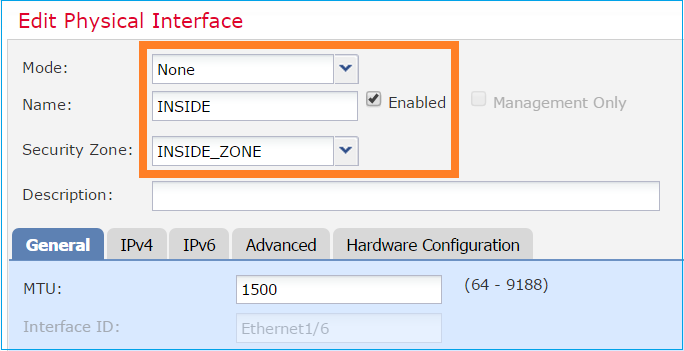
Passaggio 2. Configurare la coppia inline.
Passate a Insiemi in linea (Inline Sets) > Aggiungi insieme in linea (Add Inline Set) come mostrato nell'immagine.
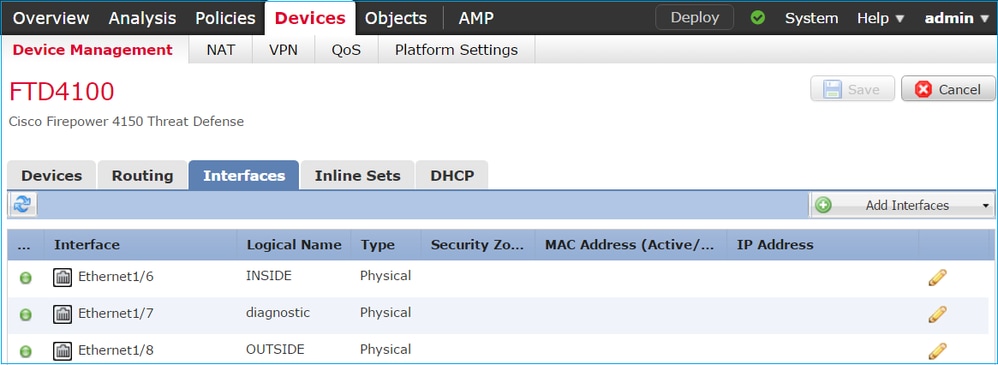
Passaggio 3. Configurare le impostazioni generali in base ai requisiti come mostrato nell'immagine.
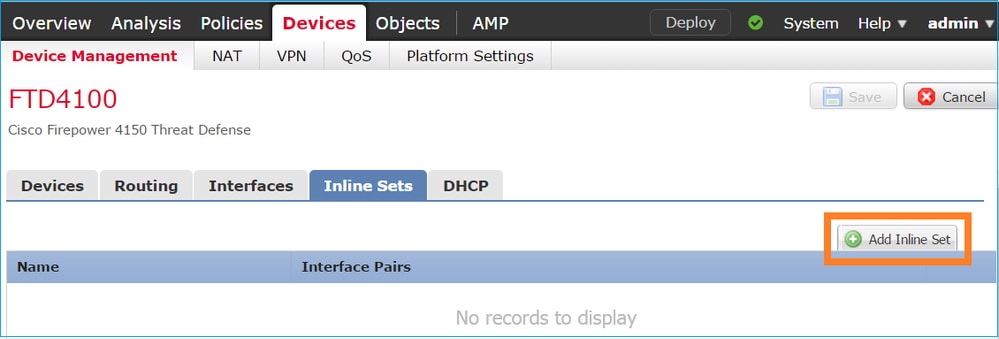
Passaggio 4. Abilitare l'opzione Propaga stato collegamento nelle Impostazioni avanzate come mostrato nell'immagine.
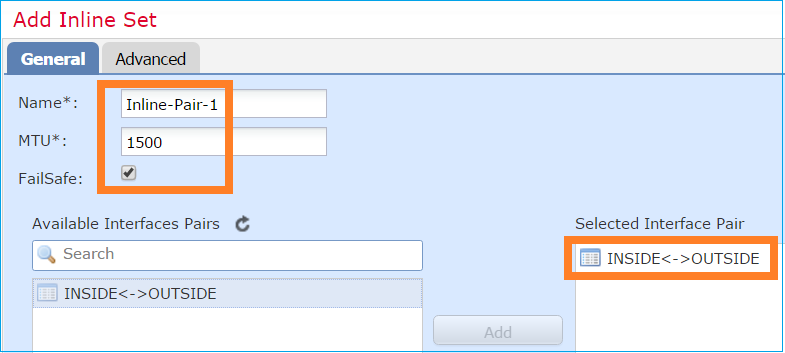
La propagazione dello stato del collegamento riduce automaticamente la seconda interfaccia nella coppia di interfacce inline quando una delle interfacce nel set inline diventa inattiva.
Passaggio 5. Salvare le modifiche e distribuire.
Verifica
Fare riferimento a questa sezione per verificare che la configurazione funzioni correttamente.
Verificare la configurazione della coppia inline dalla CLI FTD.
Soluzione
Accedere alla CLI FTD e verificare la configurazione della coppia inline:
firepower# show inline-set
Inline-set Inline-Pair-1
Mtu is 1500 bytes
Fail-open for snort down is on
Fail-open for snort busy is off
Tap mode is off
Propagate-link-state option is on
hardware-bypass mode is disabled
Interface-Pair[1]:
Interface: Ethernet1/4 "OUTSIDE"
Current-Status: UP
Interface: Ethernet1/3 "INSIDE"
Current-Status: UP
Bridge Group ID: 507
Nota: L'ID gruppo bridge è un valore diverso da 0. Se Modalità tocco è attiva, il valore è 0.
Informazioni sull'interfaccia e sul nome:
firepower# show nameif
Interface Name Security
Ethernet1/1 management 0
Ethernet1/3 INSIDE 0
Ethernet1/4 OUTSIDE 0
Verificare lo stato dell'interfaccia:
firepower# show interface ip brief
Interface IP-Address OK? Method Status Protocol
Internal-Control0/0 unassigned YES unset up up
Internal-Data0/0 unassigned YES unset up up
Internal-Data0/1 unassigned YES unset up up
Internal-Data0/2 169.254.1.1 YES unset up up
Internal-Data0/3 unassigned YES unset up up
Internal-Data0/4 unassigned YES unset down up
Ethernet1/1 203.0.113.130 YES unset up up
Ethernet1/3 unassigned YES unset up up
Ethernet1/4 unassigned YES unset up up
Verificare le informazioni sull'interfaccia fisica:
firepower# show interface e1/3
Interface Ethernet1/3 "INSIDE", is up, line protocol is up
Hardware is EtherSVI, BW 1000 Mbps, DLY 10 usec
MAC address ac4a.670e.641e, MTU 1500
IPS Interface-Mode: inline, Inline-Set: Inline-Pair-1
IP address unassigned
Traffic Statistics for "INSIDE":
170 packets input, 12241 bytes
41 packets output, 7881 bytes
9 packets dropped
1 minute input rate 0 pkts/sec, 37 bytes/sec
1 minute output rate 0 pkts/sec, 19 bytes/sec
1 minute drop rate, 0 pkts/sec
5 minute input rate 0 pkts/sec, 34 bytes/sec
5 minute output rate 0 pkts/sec, 23 bytes/sec
5 minute drop rate, 0 pkts/sec
Verifica funzionamento interfaccia a coppia inline FTD
In questa sezione vengono illustrati i controlli di verifica per verificare il funzionamento di Inline Pair:
- Verifica 1. Con l'uso di packet-tracer.
- Verifica 2. Abilita l'acquisizione con traccia e invia un pacchetto di sincronizzazione/conferma TCP (SYN/ACK) tramite la coppia inline.
- Verifica 3. Monitoraggio del traffico FTD con l'utilizzo del debug del motore del firewall
- Verifica 4. Verificare la funzionalità di propagazione dello stato del collegamento.
- Verifica 5. Configurare NAT (Static Network Address Translation).
Soluzione
Panoramica dell'architettura
Quando due interfacce FTD funzionano in modalità Inline-pair, viene gestito un pacchetto, come mostrato nell'immagine.
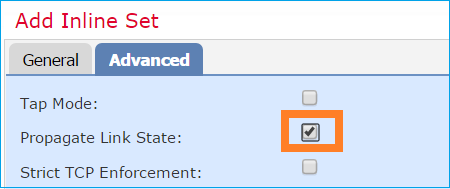
Nota: Solo le interfacce fisiche possono essere membri di un set di coppie inline.
Teoria base
- Quando si configura una coppia inline 2 fisica, le interfacce vengono collegate internamente.
- Molto simile al classico IPS (Intrusion Prevention System) in linea.
- Disponibile in modalità di distribuzione instradata o trasparente.
- La maggior parte delle funzionalità del motore LINA (NAT, Routing e così via) non è disponibile per i flussi che passano attraverso una coppia inline.
- Il traffico di transito può essere scartato.
- Alcuni controlli del motore LINA vengono applicati insieme a controlli completi del motore Snort.
L'ultimo punto può essere visualizzato come mostrato nell'immagine:
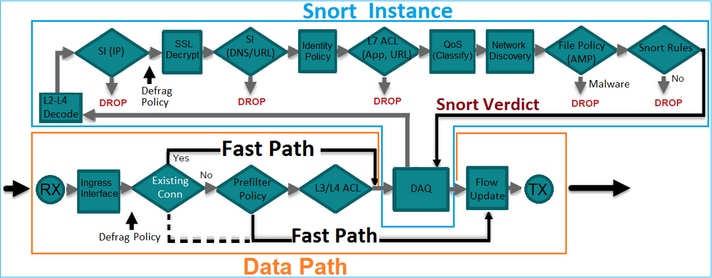
Verifica 1. Con l'uso di Packet-Tracer
L'output packet-tracer che emula un pacchetto che attraversa la coppia inline con i punti importanti evidenziati:
firepower# packet-tracer input INSIDE tcp 192.168.201.50 1111 192.168.202.50 80
Phase: 1
Type: NGIPS-MODE
Subtype: ngips-mode
Result: ALLOW
Elapsed time: 11834 ns
Config:
Additional Information:
The flow ingressed an interface configured for NGIPS mode and NGIPS services will be applied
Phase: 2
Type: ACCESS-LIST
Subtype:
Result: ALLOW
Elapsed time: 11834 ns
Config:
access-group CSM_FW_ACL_ global
access-list CSM_FW_ACL_ advanced permit ip host 192.168.201.50 host 192.168.202.50 rule-id 268451044
access-list CSM_FW_ACL_ remark rule-id 268451044: ACCESS POLICY: mzafeiro_2m - Mandatory
access-list CSM_FW_ACL_ remark rule-id 268451044: L7 RULE: New-Rule-#1303-ALLOW
Additional Information:
This packet will be sent to snort for additional processing where a verdict will be reached
Phase: 3
Type: NGIPS-EGRESS-INTERFACE-LOOKUP
Subtype: Resolve Egress Interface
Result: ALLOW
Elapsed time: 2440 ns
Config:
Additional Information:
Ingress interface INSIDE is in NGIPS inline mode.
Egress interface OUTSIDE is determined by inline-set configuration
Phase: 4
Type: FLOW-CREATION
Subtype:
Result: ALLOW
Elapsed time: 68320 ns
Config:
Additional Information:
New flow created with id 1801, packet dispatched to next module
Phase: 5
Type: EXTERNAL-INSPECT
Subtype:
Result: ALLOW
Elapsed time: 18056 ns
Config:
Additional Information:
Application: 'SNORT Inspect'
Phase: 6
Type: SNORT
Subtype: identity
Result: ALLOW
Elapsed time: 13668 ns
Config:
Additional Information:
user id: no auth, realm id: 0, device type: 0, auth type: invalid, auth proto: basic, username: none, AD domain: none,
src sgt: 0, src sgt type: unknown, dst sgt: 0, dst sgt type: unknown, abp src: none, abp dst: none, location: none
Phase: 7
Type: SNORT
Subtype: firewall
Result: ALLOW
Elapsed time: 67770 ns
Config:
Network 0, Inspection 0, Detection 0, Rule ID 268451044
Additional Information:
Starting rule matching, zone -1 -> -1, geo 0 -> 0, vlan 0, src sgt: 0, src sgt type: unknown, dst sgt: 0, dst sgt type: unknown, user 9999997, no url or host, no xff
Matched rule ids 268451044 - Allow
Phase: 8
Type: SNORT
Subtype: appid
Result: ALLOW
Elapsed time: 11002 ns
Config:
Additional Information:
service: (0), client: (0), payload: (0), misc: (0)
Result:
input-interface: INSIDE(vrfid:0)
input-status: up
input-line-status: up
output-interface: OUTSIDE(vrfid:0)
output-status: up
output-line-status: up
Action: allow
Time Taken: 204924 ns
Verifica 2. Invio dei pacchetti TCP SYN/ACK tramite una coppia inline
È possibile generare pacchetti TCP SYN/ACK con l'uso di un pacchetto che crea un'utilità come Scapy. Questa sintassi genera 3 pacchetti con flag SYN/ACK abilitati:
root@KALI:~# scapy INFO: Can't import python gnuplot wrapper . Won't be able to plot. WARNING: No route found for IPv6 destination :: (no default route?) Welcome to Scapy (2.2.0) >>> conf.iface='eth0' >>> packet = IP(dst="192.168.201.60")/TCP(flags="SA",dport=80) >>> syn_ack=[] >>> for i in range(0,3): # Send 3 packets ... syn_ack.extend(packet) ... >>> send(syn_ack)
Abilitare questa acquisizione sulla CLI FTD e inviare alcuni pacchetti TCP SYN/ACK:
firepower# capture CAPI interface INSIDE trace match ip host 192.168.201.60 any
firepower# capture CAPO interface OUTSIDE match ip host 192.168.201.60 any
Le clip mostrano che i pacchetti SYN/ACK 3 attraversano l'FTD:
firepower# show capture CAPI
3 packets captured
1: 09:20:18.206440 192.168.201.50.20 > 192.168.201.60.80: S 0:0(0) ack 0 win 8192
2: 09:20:18.208180 192.168.201.50.20 > 192.168.201.60.80: S 0:0(0) ack 0 win 8192
3: 09:20:18.210026 192.168.201.50.20 > 192.168.201.60.80: S 0:0(0) ack 0 win 8192
3 packets shown
firepower# show capture CAPO
3 packets captured
1: 09:20:18.206684 192.168.201.50.20 > 192.168.201.60.80: S 0:0(0) ack 0 win 8192
2: 09:20:18.208210 192.168.201.50.20 > 192.168.201.60.80: S 0:0(0) ack 0 win 8192
3: 09:20:18.210056 192.168.201.50.20 > 192.168.201.60.80: S 0:0(0) ack 0 win 8192
3 packets shown
La traccia del primo pacchetto di acquisizione rivela alcune informazioni aggiuntive come il verdetto del motore Snort:
firepower# show capture CAPI packet-number 1 trace
3 packets captured
1: 09:20:18.206440 192.168.201.50.20 > 192.168.201.60.80: S 0:0(0) ack 0 win 8192
Phase: 1
Type: NGIPS-MODE
Subtype: ngips-mode
Result: ALLOW
Elapsed time: 5978 ns
Config:
Additional Information:
The flow ingressed an interface configured for NGIPS mode and NGIPS services will be applied
Phase: 2
Type: ACCESS-LIST
Subtype:
Result: ALLOW
Elapsed time: 5978 ns
Config:
access-group CSM_FW_ACL_ global
access-list CSM_FW_ACL_ advanced permit ip host 192.168.201.50 object-group FMC_INLINE_dst_rule_268451044 rule-id 268451044
access-list CSM_FW_ACL_ remark rule-id 268451044: ACCESS POLICY: mzafeiro_2m - Mandatory
access-list CSM_FW_ACL_ remark rule-id 268451044: L7 RULE: New-Rule-#1303-ALLOW
object-group network FMC_INLINE_dst_rule_268451044
network-object 192.168.202.50 255.255.255.255
network-object 192.168.201.60 255.255.255.255
Additional Information:
This packet will be sent to snort for additional processing where a verdict will be reached
Phase: 3
Type: NGIPS-EGRESS-INTERFACE-LOOKUP
Subtype: Resolve Egress Interface
Result: ALLOW
Elapsed time: 1952 ns
Config:
Additional Information:
Ingress interface INSIDE is in NGIPS inline mode.
Egress interface OUTSIDE is determined by inline-set configuration
Phase: 4
Type: FLOW-CREATION
Subtype:
Result: ALLOW
Elapsed time: 45872 ns
Config:
Additional Information:
New flow created with id 1953, packet dispatched to next module
Phase: 5
Type: EXTERNAL-INSPECT
Subtype:
Result: ALLOW
Elapsed time: 18544 ns
Config:
Additional Information:
Application: 'SNORT Inspect'
Phase: 6
Type: SNORT
Subtype: identity
Result: ALLOW
Elapsed time: 25182 ns
Config:
Additional Information:
user id: no auth, realm id: 0, device type: 0, auth type: invalid, auth proto: basic, username: none, AD domain: none,
src sgt: 0, src sgt type: unknown, dst sgt: 0, dst sgt type: unknown, abp src: none, abp dst: none, location: none
Phase: 7
Type: SNORT
Subtype: firewall
Result: ALLOW
Elapsed time: 50924 ns
Config:
Network 0, Inspection 0, Detection 0, Rule ID 268451044
Additional Information:
Starting rule matching, zone -1 -> -1, geo 0 -> 0, vlan 0, src sgt: 0, src sgt type: unknown, dst sgt: 0, dst sgt type: unknown, user 9999997, no url or host, no xff
Matched rule ids 268451044 - Allow
Phase: 8
Type: SNORT
Subtype: appid
Result: ALLOW
Elapsed time: 17722 ns
Config:
Additional Information:
service: (0), client: (0), payload: (0), misc: (0)
Result:
input-interface: INSIDE(vrfid:0)
input-status: up
input-line-status: up
output-interface: OUTSIDE(vrfid:0)
output-status: up
output-line-status: up
Action: allow
Time Taken: 172152 ns
1 packet shown
La traccia del secondo pacchetto acquisito mostra che il pacchetto corrisponde a una connessione corrente, quindi ignora il controllo ACL, ma viene comunque ispezionato dal motore Snort:
firepower# show capture CAPI packet-number 2 trace
3 packets captured
2: 09:20:18.208180 192.168.201.50.20 > 192.168.201.60.80: S 0:0(0) ack 0 win 8192
Phase: 1
Type: FLOW-LOOKUP
Subtype:
Result: ALLOW
Elapsed time: 1952 ns
Config:
Additional Information:
Found flow with id 1953, using existing flow
Phase: 2
Type: EXTERNAL-INSPECT
Subtype:
Result: ALLOW
Elapsed time: 7320 ns
Config:
Additional Information:
Application: 'SNORT Inspect'
Phase: 3
Type: SNORT
Subtype: appid
Result: ALLOW
Elapsed time: 1860 ns
Config:
Additional Information:
service: (0), client: (0), payload: (0), misc: (0)
Result:
input-interface: INSIDE(vrfid:0)
input-status: up
input-line-status: up
Action: allow
Time Taken: 11132 ns
1 packet shown
Verifica 3. Debug Del Motore Firewall Per Il Traffico Autorizzato
Il debug del motore del firewall viene eseguito su componenti specifici del motore dello snort FTD, ad esempio i criteri di controllo dell'accesso, come mostrato nell'immagine:

Quando si inviano i pacchetti TCP SYN/ACK tramite Inline Pair, è possibile vedere nell'output del comando debug:
> system support firewall-engine-debug
Please specify an IP protocol: tcp
Please specify a client IP address:
Please specify a client port:
Please specify a server IP address: 192.168.201.60
Please specify a server port: 80
Monitoring firewall engine debug messages
192.168.201.60-80 > 192.168.201.50-20 6 AS 4 I 12 New session
192.168.201.60-80 > 192.168.201.50-20 6 AS 4 I 12 using HW or preset rule order 3, id 268438528 action Allow and prefilter rule 0
192.168.201.60-80 > 192.168.201.50-20 6 AS 4 I 12 allow action
192.168.201.60-80 > 192.168.201.50-20 6 AS 4 I 12 Deleting session
Verifica 4. Verifica della propagazione dello stato del collegamento
Abilitare il buffer log su FTD e chiudere la porta dello switch collegata all'interfaccia e1/4. Dalla CLI di FTD, è necessario notare che entrambe le interfacce sono disabilitate:
firepower# show interface ip brief
Interface IP-Address OK? Method Status Protocol
Internal-Control0/0 unassigned YES unset up up
Internal-Data0/0 unassigned YES unset up up
Internal-Data0/1 unassigned YES unset up up
Internal-Data0/2 169.254.1.1 YES unset up up
Internal-Data0/3 unassigned YES unset up up
Internal-Data0/4 unassigned YES unset down up
Ethernet1/1 203.0.113.130 YES unset up up
Ethernet1/3 unassigned YES unset admin down down
Ethernet1/4 unassigned YES unset down down
I log FTD mostrano:
firepower# show log
...
May 28 2024 07:35:10: %FTD-4-411002: Line protocol on Interface Ethernet1/4, changed state to down
May 28 2024 07:35:10: %FTD-4-411004: Interface INSIDE, changed state to administratively down
May 28 2024 07:35:10: %FTD-4-411004: Interface Ethernet1/3, changed state to administratively down
May 28 2024 07:35:10: %FTD-4-812005: Link-State-Propagation activated on inline-pair due to failure of interface Ethernet1/4(OUTSIDE) bringing down pair interface Ethernet1/3(INSIDE)
May 28 2024 07:35:10: %FTD-4-411002: Line protocol on Interface Ethernet1/3, changed state to down
Lo stato inline-set mostra lo stato dei due membri dell'interfaccia:
firepower# show inline-set
Inline-set Inline-Pair-1
Mtu is 1500 bytes
Fail-open for snort down is on
Fail-open for snort busy is off
Tap mode is off
Propagate-link-state option is on
hardware-bypass mode is disabled
Interface-Pair[1]:
Interface: Ethernet1/4 "OUTSIDE"
Current-Status: Down(Propagate-Link-State-Activated)
Interface: Ethernet1/3 "INSIDE"
Current-Status: Down(Administrative-Down-By-Propagate-Link-State)
Bridge Group ID: 507
Si noti la differenza nello stato delle due interfacce:
firepower# show interface e1/3
Interface Ethernet1/3 "INSIDE", is admin down, line protocol is down
Hardware is EtherSVI, BW 1000 Mbps, DLY 10 usec
MAC address ac4a.670e.641e, MTU 1500
IPS Interface-Mode: inline, Inline-Set: Inline-Pair-1
Administrative-Down-By-Propagate-Link-State
IP address unassigned
Traffic Statistics for "INSIDE":
2400 packets input, 165873 bytes
1822 packets output, 178850 bytes
17 packets dropped
1 minute input rate 0 pkts/sec, 0 bytes/sec
1 minute output rate 0 pkts/sec, 0 bytes/sec
1 minute drop rate, 0 pkts/sec
5 minute input rate 0 pkts/sec, 32 bytes/sec
5 minute output rate 0 pkts/sec, 57 bytes/sec
5 minute drop rate, 0 pkts/sec
firepower# show interface e1/4
Interface Ethernet1/4 "OUTSIDE", is down, line protocol is down
Hardware is EtherSVI, BW 1000 Mbps, DLY 10 usec
MAC address ac4a.670e.640e, MTU 1500
IPS Interface-Mode: inline, Inline-Set: Inline-Pair-1
Propagate-Link-State-Activated
IP address unassigned
Traffic Statistics for "OUTSIDE":
1893 packets input, 158046 bytes
2386 packets output, 213997 bytes
67 packets dropped
1 minute input rate 0 pkts/sec, 0 bytes/sec
1 minute output rate 0 pkts/sec, 0 bytes/sec
1 minute drop rate, 0 pkts/sec
5 minute input rate 0 pkts/sec, 51 bytes/sec
5 minute output rate 0 pkts/sec, 39 bytes/sec
5 minute drop rate, 0 pkts/sec
Dopo aver riattivato la porta dello switch, nei log FTD vengono visualizzati:
May 28 2024 07:38:04: %FTD-4-411001: Line protocol on Interface Ethernet1/4, changed state to up
May 28 2024 07:38:04: %FTD-4-411003: Interface Ethernet1/3, changed state to administratively up
May 28 2024 07:38:04: %FTD-4-411003: Interface INSIDE, changed state to administratively up
May 28 2024 07:38:04: %FTD-4-812006: Link-State-Propagation de-activated on inline-pair due to recovery of interface Ethernet1/4(OUTSIDE) bringing up pair interface Ethernet1/3(INSIDE)
May 28 2024 07:38:05: %FTD-4-411002: Line protocol on Interface Ethernet1/4, changed state to down
Verifica 5. Configurare un NAT statico
Soluzione
NAT non è supportato per le interfacce che operano in modalità inline, inline tap o passive:
Guida alla configurazione di Firepower Management Center, versione 6.0.1
Blocca pacchetto in modalità interfaccia a coppia inline
Creare una regola di blocco, inviare il traffico attraverso la coppia inline FTD e osservare il comportamento, come mostrato nell'immagine.

Soluzione
Abilita l'acquisizione con trace e invia i pacchetti SYN/ACK tramite la coppia inline FTD. Il traffico è bloccato:
firepower# show capture
capture CAPI type raw-data trace interface INSIDE [Capturing - 270 bytes]
match ip host 192.168.201.60 any
capture CAPO type raw-data interface OUTSIDE [Capturing - 0 bytes]
match ip host 192.168.201.60 any
Nella traccia, si può vedere che il pacchetto è stato scartato dal motore LINA FTD e non è stato inoltrato al motore Snort FTD.
firepower# show capture CAPI packet-number 1 trace
4 packets captured
1: 09:41:54.562547 192.168.201.50.59144 > 192.168.201.60.80: S 3817586151:3817586151(0) win 64240 <mss 1460,sackOK,timestamp 2568467664 0,nop,wscale 7>
Phase: 1
Type: NGIPS-MODE
Subtype: ngips-mode
Result: ALLOW
Elapsed time: 10126 ns
Config:
Additional Information:
The flow ingressed an interface configured for NGIPS mode and NGIPS services will be applied
Phase: 2
Type: ACCESS-LIST
Subtype:
Result: DROP
Elapsed time: 10126 ns
Config:
access-group CSM_FW_ACL_ global
access-list CSM_FW_ACL_ advanced deny ip any host 192.168.201.60 rule-id 268451045 event-log flow-start
access-list CSM_FW_ACL_ remark rule-id 268451045: ACCESS POLICY: mzafeiro_2m - Mandatory
access-list CSM_FW_ACL_ remark rule-id 268451045: L4 RULE: block_192.168.201.60
Additional Information:
Result:
input-interface: INSIDE(vrfid:0)
input-status: up
input-line-status: up
Action: drop
Time Taken: 20252 ns
1 packet shown
Configura La Modalità Inline Pair Con Tap
Abilitare la modalità Tap sulla coppia inline.
Soluzione
Passare a Dispositivi > Gestione periferiche > Insiemi in linea > Modifica insieme in linea > Avanzate e attivare la modalità maschiatura, come mostrato nell'immagine.

Verifica
firepower# show inline-set
Inline-set Inline-Pair-1
Mtu is 1500 bytes
Fail-open for snort down is off
Fail-open for snort busy is off
Tap mode is on
Propagate-link-state option is on
hardware-bypass mode is disabled
Interface-Pair[1]:
Interface: Ethernet1/4 "OUTSIDE"
Current-Status: UP
Interface: Ethernet1/3 "INSIDE"
Current-Status: UP
Bridge Group ID: 0
Verifica coppia inline FTD con funzionamento interfaccia tap
Teoria base
- Quando si configura una coppia inline con tap, le interfacce fisiche vengono collegate internamente tramite bridge.
- È disponibile in modalità di distribuzione instradata o trasparente.
- La maggior parte delle funzionalità del motore LINA (NAT, Routing e così via) non sono disponibili per i flussi che passano attraverso la coppia in linea.
- Impossibile eliminare il traffico effettivo.
- Alcuni controlli del motore LINA vengono applicati insieme a controlli completi del motore Snort su una copia del traffico effettivo.
L'opzione Inline Pair with Tap Mode (Accoppia inline con modalità tap) non elimina il traffico di transito. Con la traccia di un pacchetto conferma questo:
> show capture CAPI packet-number 2 trace 3 packets captured 2: 13:34:30.685084 192.168.201.50.20 > 192.168.201.60.80: S 0:0(0) win 8192 Phase: 1 Type: CAPTURE Subtype: Result: ALLOW Config: Additional Information: MAC Access list Phase: 2 Type: ACCESS-LIST Subtype: Result: ALLOW Config: Implicit Rule Additional Information: MAC Access list Phase: 3 Type: NGIPS-MODE Subtype: ngips-mode Result: ALLOW Config: Additional Information: The flow ingressed an interface configured for NGIPS mode and NGIPS services is applied Phase: 4 Type: ACCESS-LIST Subtype: log Result: WOULD HAVE DROPPED Config: access-group CSM_FW_ACL_ global access-list CSM_FW_ACL_ advanced deny ip 192.168.201.0 255.255.255.0 any rule-id 268441600 event-log flow-start access-list CSM_FW_ACL_ remark rule-id 268441600: ACCESS POLICY: FTD4100 - Mandatory/1 access-list CSM_FW_ACL_ remark rule-id 268441600: L4 RULE: Rule 1 Additional Information: Result: input-interface: INSIDE input-status: up input-line-status: up Action: Access-list would have dropped, but packet forwarded due to inline-tap 1 packet shown
>
Coppia inline ed Etherchannel
È possibile configurare una coppia inline con etherchannel in 2 modi:
- Etherchannel terminato su FTD.
- Etherchannel passa attraverso il FTD (richiede il codice FXOS 2.3.1.3 e versioni successive).
Etherchannel terminato su FTD
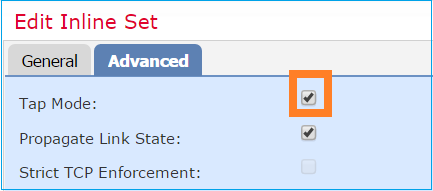
Etherchannel su SW-A:
SW-A# show etherchannel summary | i Po33|Po55 33 Po33(SU) LACP Gi3/11(P) 35 Po35(SU) LACP Gi2/33(P)
Etherchannel su SW-B:
SW-B# show etherchannel summary | i Po33|Po55 33 Po33(SU) LACP Gi1/0/3(P) 55 Po55(SU) LACP Gi1/0/4(P)
Il traffico viene inoltrato tramite l'FTD attivo in base all'apprendimento dell'indirizzo MAC:
SW-B# show mac address-table address 0017.dfd6.ec00
Mac Address Table
-------------------------------------------
Vlan Mac Address Type Ports
---- ----------- -------- -----
201 0017.dfd6.ec00 DYNAMIC Po33
Total Mac Addresses for this criterion: 1
Il set in linea su FTD:
FTD# show inline-set
Inline-set SET1
Mtu is 1500 bytes
Fail-open for snort down is on
Fail-open for snort busy is off
Tap mode is off
Propagate-link-state option is off
hardware-bypass mode is disabled
Interface-Pair[1]:
Interface: Port-channel3 "INSIDE"
Current-Status: UP
Interface: Port-channel5 "OUTSIDE"
Current-Status: UP
Bridge Group ID: 775
Nota: In caso di evento di failover FTD, l'interruzione del traffico dipende principalmente dal tempo impiegato dagli switch per conoscere l'indirizzo MAC del peer remoto.
Etherchannel tramite FTD
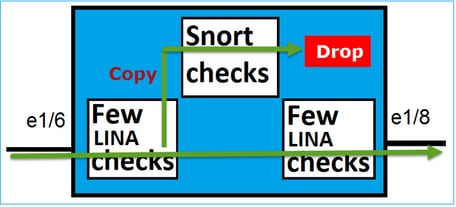
Etherchannel su SW-A:
SW-A# show etherchannel summary | i Po33|Po55
33 Po33(SU) LACP Gi3/11(P)
55 Po55(SD) LACP Gi3/7(I)
I pacchetti LACP attraverso l'FTD standby sono bloccati:
FTD# capture ASP type asp-drop fo-standby FTD# show capture ASP | i 0180.c200.0002 29: 15:28:32.658123 a0f8.4991.ba03 0180.c200.0002 0x8809 Length: 124 70: 15:28:47.248262 f0f7.556a.11e2 0180.c200.0002 0x8809 Length: 124
Etherchannel su SW-B:
SW-B# show etherchannel summary | i Po33|Po55
33 Po33(SU) LACP Gi1/0/3(P)
55 Po55(SD) LACP Gi1/0/4(s)
Il traffico viene inoltrato tramite l'FTD attivo in base all'apprendimento dell'indirizzo MAC:
SW-B# show mac address-table address 0017.dfd6.ec00
Mac Address Table
-------------------------------------------
Vlan Mac Address Type Ports
---- ----------- -------- -----
201 0017.dfd6.ec00 DYNAMIC Po33
Total Mac Addresses for this criterion: 1
Il set in linea su FTD:
FTD# show inline-set
Inline-set SET1
Mtu is 1500 bytes
Fail-open for snort down is on
Fail-open for snort busy is off
Tap mode is off
Propagate-link-state option is off
hardware-bypass mode is disabled
Interface-Pair[1]:
Interface: Ethernet1/3 "INSIDE"
Current-Status: UP
Interface: Ethernet1/5 "OUTSIDE"
Current-Status: UP
Bridge Group ID: 519
Attenzione: In questo scenario, nel caso di un evento di failover FTD, il tempo di convergenza dipende principalmente dalla negoziazione LACP Etherchannel e dal tempo necessario per l'interruzione, che può essere molto più lungo. Se la modalità Etherchannel è impostata su ON (nessun LACP), il tempo di convergenza dipende dall'apprendimento dell'indirizzo MAC.
Risoluzione dei problemi
Nessuna informazione specifica disponibile per questa configurazione.
Confronto: Doppino inline e coppia inline con tap
| Coppia inline |
Coppia inline con tap |
|
| show inline-set |
> show inline-set |
> show inline-set > |
| show interface |
> show interface e1/6 |
> show interface e1/6 |
| Per gestire il pacchetto con la regola di blocco |
> show capture CAPI packet-number 1 trace |
> show capture CAPI packet-number 1 trace |
Riepilogo
- Quando si usa la modalità Inline Pair, il pacchetto passa principalmente attraverso il motore Snort FTD.
- Le connessioni TCP vengono gestite in modalità TCP state-bypass.
- Dal punto di vista di un motore LINA FTD, viene applicato un criterio ACL.
- Quando è in uso la modalità Inline Pair, i pacchetti possono essere bloccati perché vengono elaborati in linea.
- Quando la modalità tap è abilitata, una copia del pacchetto viene ispezionata e scartata internamente, mentre il traffico effettivo attraversa l'FTD senza modifiche.
Informazioni correlate
Cronologia delle revisioni
| Revisione | Data di pubblicazione | Commenti |
|---|---|---|
3.0 |
18-Nov-2024 |
La finestra delle informazioni interne di Cisco è stata rimossa perché il collegamento non è stato trovato.
Introduzione, Testo alternativo e Formattazione aggiornati. |
2.0 |
28-Apr-2023 |
Certificazione |
1.0 |
18-Oct-2017 |
Versione iniziale |
Contributo dei tecnici Cisco
- Mikis ZafeiroudisTecnico di consulenza
- Dinkar SharmaTecnico di consulenza
 Feedback
Feedback